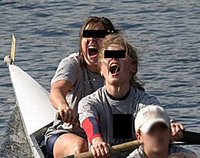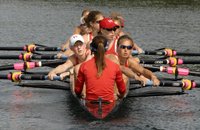The final set of questions deals with the depth of women's lightweight rowing and its future:
4) Observers frequently decry the limited depth of women’s lightweight rowing. In fact, in the last ten years, four different schools have won the men’s heavyweight championship, five different schools have won the women’s heavyweight championship, and four different schools have won the lightweight women’s national championship. While I wouldn’t claim parity in lightweight rowing just yet, there are more schools coming on the scene with varsity or dedicated programs – Georgetown and Stanford of course, and now UCF and URI among others. As a final catch-all question, where do you see lightweight women’s rowing going in the future and how can more schools be encouraged to start dedicated programs?
This last set of questions allowed the coaches to make a variety of points, and they did just that. The tone was generally quite optimistic. Let me try to group the responses around common themes.
One theme was the idea that the overall growth in rowing will result in growth in lightweight women's rowing. At the same time, the growth dampening effect of the NCAA championship format was noted. As long as the 2V counts toward the team championship, heavyweight coaches will always feel as if they are hurting themselves by allowing good lightweights to row on a lightweight squad. This thinking leads one to look to schools with little chance of competing at NCAAs for growth in lightweight rowing.
Another theme was the idea that as more programs successfully race lightweights, and show that at well run programs weight problems are a figment of someone's imagination, the sport will grow. Parents and administrators will stop believing the apocalyptic stories of anorexic rowers and start encouraging their lightweight daughters and athletes to row lightweight.
One coach took the depth criticism head on by comparing the number of girls who play soccer to the number of heavyweight men who row, and using that to illustrate the relative lack of depth in all of rowing. While quick to say that this doesn't invalidate the sport, and acknowledging that it still takes incredible talent and dedication to be a rowing champion, this coach goes on to say that the very top of every category is not particularly deep. In one of the more telling comments to these questions, this coach notes that 10 or 15 years ago lightweight men's rowing was not very deep yet it had been around for 70 years or so. Women's lightweight rowing is growing at a faster rate and with time and support should soon be just as exciting as the light men.
A very interesting response came from a coach who said that lightweight women's rowing needs a hero, someone like Mia Hamm or Tiger Woods. (At Eastern Sprints I had a conversation with a coach who ran a summer developmental lightweight program who said the same thing.) This coach noted that recent female sports heros such as Mia Hamm and Michelle Wie have been "the youngest to ever..." Recently China's Fan Xuefei became the youngest world champion ever, racing in the lightweight quad. Will she inspire more lightweights? The coach doesn't know, but still makes a great point. The problem is that in a society that loves heros and celebrities, rowing is the ultimate team sport. Maybe lightweight rowing can trump the other categories by being the first to create a hero.
I should note that one coach mentioned the hard work done by Cecile Tucker of Radcliffe who heads the CRCA lightweight committee.
Overall, it's great to see optimism from these coaches. Even better, is to realize these are the coaches who will support this sport as it grows. The coaches who are collecting data to dispel the health concerns, coaches who are working to integrate lightweights into more regattas, and coaches who are developing lightweight heros. Given the track record of the mainstream sports and rowing media, it's clear that lightweight heros or celebrities (I'm thinking of crews as much as individuals) won't come out of traditional channels. The sport itself will have to take responsibility for its own publicity. There's no shame in tooting your own horn and lightweights shouldn't shy away from doing that. There are plenty of great stories to tell, if only we could get them out (recall how Rowing News almost totally ignored the category in its 2006 season preview).
Most distressing once again is the way heavyweight programs and the NCAA cast a shadow over lightweight rowing. One of, if not the, biggest challenge in lightweight rowing is how to turn heavyweight coaches and the NCAA from opponents into supporters. Even just removing them as obstacles would be progress. The size of heavyweight rowing versus lightweight rowing allows the heavyweight coaches to simply ignore lightweights while claiming they support the category. As one coach pointed out, these coaches and the NCAA need to open their eyes and look at Radcliffe, Harvard, Princeton men and women, Yale men, and Wisconsin women to see examples of programs that do both well. In fact, it could be argued that these programs are the cream of the crop and they all have one thing in common - lightweight AND heavyweight programs.












